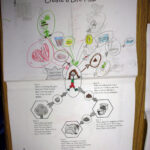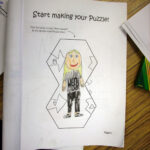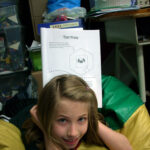Across ten days in February and March, we brought our Puzzle-based Systems and Ecosystems program to about 40 fourth and fifth graders in Burbank. A good time was had by all, and the school kindly allowed us to take some photos to share.
[gallery link="file" ids="1036,1034,1033"]
[caption id="attachment_1029" align="alignright" width="150"]

A life map, the first step in creating a Puzzle of Me.[/caption]
The main project in the Systems and Ecosystems program is
The Puzzle of Me. Here, students use the ideas from The Puzzle of Life to create their own version of the Puzzle. The difference is that, in this version, the Puzzle is centered not on the sun - but on themselves. The first step of this project is to create a life map to show the many ways that you are connected to the world around you. This map serves as a blueprint for a Puzzle, showing both objects (which become tiles) and flows (which become the arrows between the tiles). We encourage students to think several steps out, and hope that they create life maps that show both direct and indirect relationships, and that show both tangibles (e.g. food) and intangibles (e.g. music, love, ideas).

After creating a map, the next step is to create a Puzzle piece that represents yourself. That piece has in-arrows and out-arrows to show how materials and ideas flow between you and your direct connections.
From this point, students then proceed onwards in a more open fasion, and create Puzzle pieces based on the most important bits of their lives, the bits that they identified in their Life Map.
[caption id="attachment_1030" align="alignright" width="150"]

Pugs on the brain.[/caption]
One young girl was a huge fan of pugs. She originally wanted to make a Puzzle of Pug, rather than a Puzzle of herself. We talked for a bit, and we figured out that she could make a Puzzle of herself, but have pugs as high-importance direct connection. When she finished, I asked her if I could take a photo of her pug drawing. She said that I could, but only if I included her as well. I'm not sure if this was intended or not, but you can see that the out-arrow from the pug is pointed kinda towards her head, which is entirely fitting for a girl with pugs on the brain.
[caption id="attachment_1037" align="alignright" width="150"]

Passing knowledge from generation to generation.[/caption]
Another young girl drew a wonderfully colorful brain. I asked her what was going on, and she pointed to the other tile on the page, explaining how she would pass on her knowledge to her children. That made me super happy.
Overall, the program worked well for both grades. Most of the kids were highly-engaged for the entire program, which means we totally nailed our primary goal, and succeeded in creating a program which is both intellectually and emotionally engaging. The students also learned some great ideas about ecology, and more specifically, about the Yellowstone story and about trophic cascades.
Most students still struggled with the abstract concept of second- and third- (and beyond) connections. They know that they are connected to their friends, but often don't think about the way that their friends are connected to *their* friends. They don't think about the fact that friends-of-friends can be relevant, even if you never meet or hear of them. We could see this in their life maps, very few of which contained meaningful indirect connections, but we got some good feedback on how we can improve our presentation so as make this abstract idea more approachable.
This is, I believe, as it should be. Just as these kids learn about science from us, so do we learn about learning from them. The fact that we all know that we're learning from each other creates an environment of mutual respect, and that mutual respect then allows us to have a productive learning environment.
Next up (probably tomorrow) stories from the 2016 Los Angeles Environmental Education Fair.
 A life map, the first step in creating a Puzzle of Me.[/caption]
The main project in the Systems and Ecosystems program is The Puzzle of Me. Here, students use the ideas from The Puzzle of Life to create their own version of the Puzzle. The difference is that, in this version, the Puzzle is centered not on the sun - but on themselves. The first step of this project is to create a life map to show the many ways that you are connected to the world around you. This map serves as a blueprint for a Puzzle, showing both objects (which become tiles) and flows (which become the arrows between the tiles). We encourage students to think several steps out, and hope that they create life maps that show both direct and indirect relationships, and that show both tangibles (e.g. food) and intangibles (e.g. music, love, ideas).
A life map, the first step in creating a Puzzle of Me.[/caption]
The main project in the Systems and Ecosystems program is The Puzzle of Me. Here, students use the ideas from The Puzzle of Life to create their own version of the Puzzle. The difference is that, in this version, the Puzzle is centered not on the sun - but on themselves. The first step of this project is to create a life map to show the many ways that you are connected to the world around you. This map serves as a blueprint for a Puzzle, showing both objects (which become tiles) and flows (which become the arrows between the tiles). We encourage students to think several steps out, and hope that they create life maps that show both direct and indirect relationships, and that show both tangibles (e.g. food) and intangibles (e.g. music, love, ideas).
 After creating a map, the next step is to create a Puzzle piece that represents yourself. That piece has in-arrows and out-arrows to show how materials and ideas flow between you and your direct connections.
From this point, students then proceed onwards in a more open fasion, and create Puzzle pieces based on the most important bits of their lives, the bits that they identified in their Life Map.
[caption id="attachment_1030" align="alignright" width="150"]
After creating a map, the next step is to create a Puzzle piece that represents yourself. That piece has in-arrows and out-arrows to show how materials and ideas flow between you and your direct connections.
From this point, students then proceed onwards in a more open fasion, and create Puzzle pieces based on the most important bits of their lives, the bits that they identified in their Life Map.
[caption id="attachment_1030" align="alignright" width="150"] Pugs on the brain.[/caption]
One young girl was a huge fan of pugs. She originally wanted to make a Puzzle of Pug, rather than a Puzzle of herself. We talked for a bit, and we figured out that she could make a Puzzle of herself, but have pugs as high-importance direct connection. When she finished, I asked her if I could take a photo of her pug drawing. She said that I could, but only if I included her as well. I'm not sure if this was intended or not, but you can see that the out-arrow from the pug is pointed kinda towards her head, which is entirely fitting for a girl with pugs on the brain.
[caption id="attachment_1037" align="alignright" width="150"]
Pugs on the brain.[/caption]
One young girl was a huge fan of pugs. She originally wanted to make a Puzzle of Pug, rather than a Puzzle of herself. We talked for a bit, and we figured out that she could make a Puzzle of herself, but have pugs as high-importance direct connection. When she finished, I asked her if I could take a photo of her pug drawing. She said that I could, but only if I included her as well. I'm not sure if this was intended or not, but you can see that the out-arrow from the pug is pointed kinda towards her head, which is entirely fitting for a girl with pugs on the brain.
[caption id="attachment_1037" align="alignright" width="150"] Passing knowledge from generation to generation.[/caption]
Another young girl drew a wonderfully colorful brain. I asked her what was going on, and she pointed to the other tile on the page, explaining how she would pass on her knowledge to her children. That made me super happy.
Overall, the program worked well for both grades. Most of the kids were highly-engaged for the entire program, which means we totally nailed our primary goal, and succeeded in creating a program which is both intellectually and emotionally engaging. The students also learned some great ideas about ecology, and more specifically, about the Yellowstone story and about trophic cascades.
Most students still struggled with the abstract concept of second- and third- (and beyond) connections. They know that they are connected to their friends, but often don't think about the way that their friends are connected to *their* friends. They don't think about the fact that friends-of-friends can be relevant, even if you never meet or hear of them. We could see this in their life maps, very few of which contained meaningful indirect connections, but we got some good feedback on how we can improve our presentation so as make this abstract idea more approachable.
This is, I believe, as it should be. Just as these kids learn about science from us, so do we learn about learning from them. The fact that we all know that we're learning from each other creates an environment of mutual respect, and that mutual respect then allows us to have a productive learning environment.
Next up (probably tomorrow) stories from the 2016 Los Angeles Environmental Education Fair.
Passing knowledge from generation to generation.[/caption]
Another young girl drew a wonderfully colorful brain. I asked her what was going on, and she pointed to the other tile on the page, explaining how she would pass on her knowledge to her children. That made me super happy.
Overall, the program worked well for both grades. Most of the kids were highly-engaged for the entire program, which means we totally nailed our primary goal, and succeeded in creating a program which is both intellectually and emotionally engaging. The students also learned some great ideas about ecology, and more specifically, about the Yellowstone story and about trophic cascades.
Most students still struggled with the abstract concept of second- and third- (and beyond) connections. They know that they are connected to their friends, but often don't think about the way that their friends are connected to *their* friends. They don't think about the fact that friends-of-friends can be relevant, even if you never meet or hear of them. We could see this in their life maps, very few of which contained meaningful indirect connections, but we got some good feedback on how we can improve our presentation so as make this abstract idea more approachable.
This is, I believe, as it should be. Just as these kids learn about science from us, so do we learn about learning from them. The fact that we all know that we're learning from each other creates an environment of mutual respect, and that mutual respect then allows us to have a productive learning environment.
Next up (probably tomorrow) stories from the 2016 Los Angeles Environmental Education Fair.